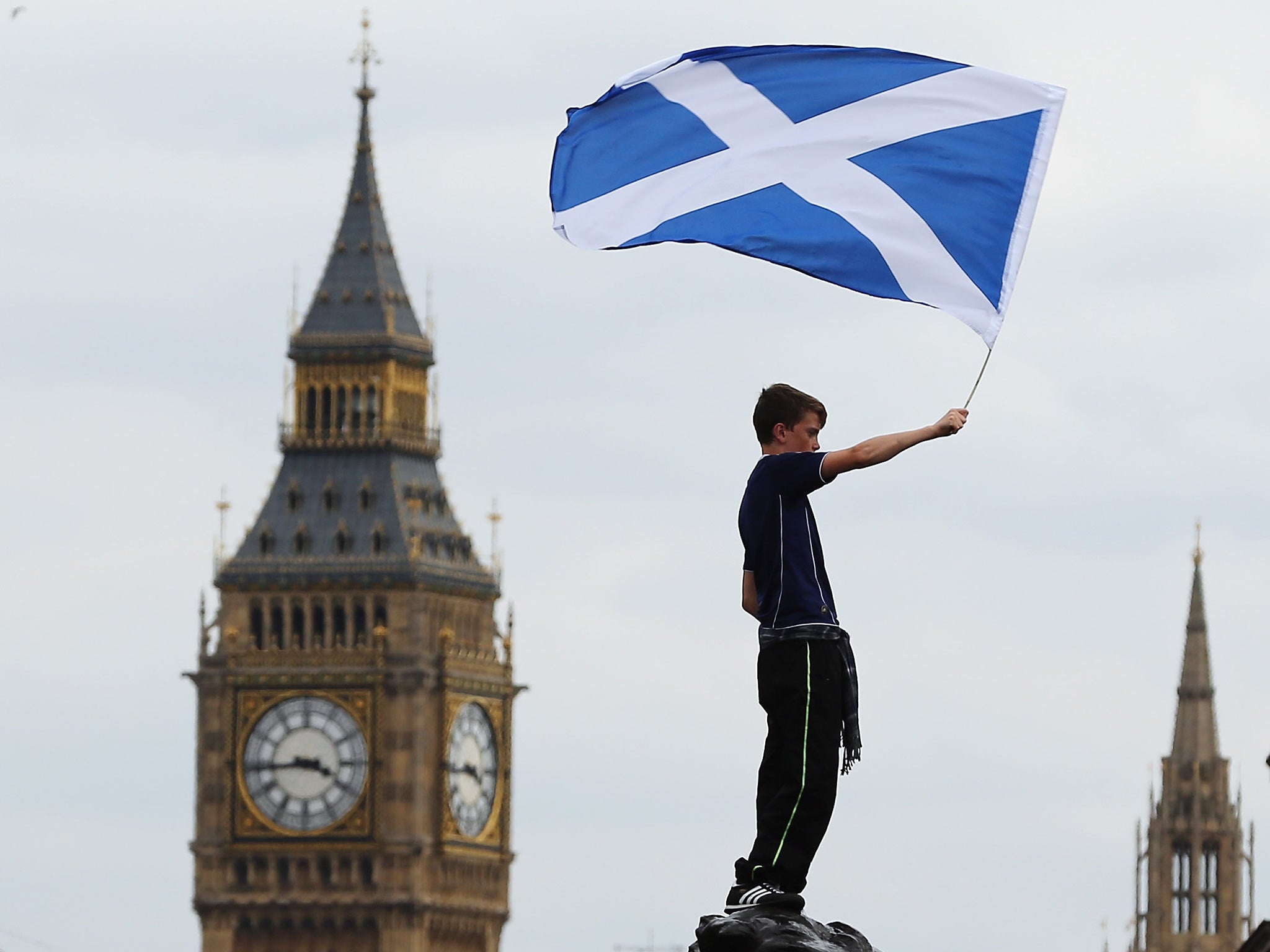Like it or not, the Scots and the English are flesh and blood
Inspect the details of this diluted nationalism and one thing becomes clear. It embraces, even celebrates, a cross-border world


Now housed at Scone Palace in Perth, a picture painted in 1779 depicts two young women: one white, one black. A grand lady stretches out an arm to touch her companion, who fixes the viewer with a bold, even insolent gaze. Together the pair look full of mischief: bags of fun, bags of trouble.
This anonymous painting was once captioned as a portrait of a lady and her “maid”. Nonsense, as the briefest glance will tell you. These girls are not just best mates and fellow-conspirators: they are cousins, kinswomen, flesh and blood. The picture used to hang in Kenwood House on the heights of Hampstead in north London. So what do Lady Elizabeth Murray and her cousin – not her servant – Dido Elizabeth Belle have to do with this week’s debate about Scottish independence and English, or British, identity? Just about everything.
Dido Belle was the illegitimate daughter of the Scottish sailor John Lindsay and an enslaved African woman, born in the West Indies. She came to Kenwood as a small child to join the household of the first Earl of Mansfield – Lindsay’s uncle – as a companion to Elizabeth, a cousin whom the Mansfields adopted. As an adult, she would go on to manage the Kenwood home farm and (most unusually) help with his confidential correspondence the mighty great‑uncle who, as visitors reported, “showed the greatest attention to everything she said”.
Earl Mansfield – the rebuilder of Kenwood – became Lord Chief Justice of England in 1756. He reformed English common and commercial law, laying the foundations for the business rules that make London today such a global hub. In the Somersett case of 1772, Dido Belle’s great-uncle found no legal basis for the enforcement of slavery in England. In many eyes, he cleared the way for its abolition in the British Empire, and across the world. (In his will, Mansfield not only left Dido a handsome legacy but confirmed her status as a free woman.)
But the earl had started life as William Murray of Perth, younger son of a Scottish noble family deeply suspect for its Jacobite loyalties. William went south and made peace with the Hanoverian dynasty (although enemies always accused him of Jacobitism). He shone in his profession – even if at Christ Church, Oxford no one could understand his accent – changed England, and arguably changed the world. It was Mansfield whom Dr Johnson meant when he told James Boswell – Edinburgh advocate turned hagiographer of the archetypal Englishman – that “Much may be made of a Scotchman, if he be caught young”. Yesterday, Kenwood House reopened to the public after a 20-month restoration by its custodians, English Heritage. Perhaps it ought to belong to Historic Scotland instead.
After the 1707 Union of Parliaments, and the failure of the 1715 and 1745 rebellions, generations of bright young Scots decided like Murray that the way south led to fortune. Aiming to wind up Boswell, as usual, Johnson declared: “The noblest prospect which a Scotchman ever sees is the high road that leads him to England!” From the age of William Murray to that of Gordon Brown and Fred Goodwin, they duly took control of the British commanding heights in politics, law, commerce and culture.
Recruited from the feudal musters of clan chieftains, Scots regiments formed the spine of the British Army. The Black Watch, incorporated in 1739, had begun as a patrol of three companies of Campbells along with Frasers, Grants and Munros. Having pacified the insurgent Highlands, these militias pacified the world. The British empire was, to a disproportionate degree, an empire of the Scots diaspora. Whether you visit the 1,600 graves of the Scottish cemetery in Kolkata or call on Jardine Matheson, the original “tai-pans” of colonial Hong Kong, the “British” footprint across the world often bears a Scottish stripe. Just listen to the pipe bands of Punjab.
These enmeshed and entangled histories lead in no single political direction. Yet it makes sense to remember them at the end of a week in which the Scottish government launched with a thump its 667-page blueprint for “Scotland’s Future” after the positive vote it seeks in the referendum on independence due on 18 September 2014. For the next nine months of fights over the future will also, inevitably, turn into a battle for the past.
Elements of bathos accompanied the unveiling of Alex Salmond’s mega-manifesto. Post-oil boom Scottish nationalism has gained emotional lift-off from tales hatched in Hollywood – rather than Holyrood – of shaggy plaid-clad warriors who gave a good hiding to those sneery English fops. Now the heirs of the Wallace and the Bruce will vote for independence thanks to “a transformational extension of childcare”, lower corporation tax, “reducing your energy bills by an average of 5 per cent” and – war cries ready – a 50 per cent reduction in air passenger duty.
That, sceptics might scoff, will really call the clans up from the glens, dirks flashing and claymores swinging. Supporters of the status quo, beware. This is no fumble but the core of a shrewd strategy. As a riposte to the “devo max” proposed by unionists, the SNP government has come up with Independence Lite. Let’s see if it sells like Irn Bru.
Inspect the details of this emollient, even diluted, nationalism and one thing becomes abundantly clear. It embraces, even celebrates, the cross-border world of William Murray – or of Gordon Brown. Look at three specific areas of controversy. Scotland, post-independence, will remain a “constitutional monarchy”, with Elizabeth II – great-great-granddaughter of the Balmoral-haunting Queen Victoria – as head of state. And who restored trust in the monarchy on both sides of the border after the disaster of the abdication crisis? Lady Elizabeth Bowes-Lyon of Glamis Castle, the Earl of Strathmore’s daughter and Queen Mother-to-be.
The reborn state will keep the pound as part of a “sterling area”, sharing fiscal management – and the partitioning of debts – with the Bank of England. Would that be the Bank of England founded in 1694 in strict accordance with a scheme laid out by William Paterson of Dumfries? Alas, Paterson’s next big idea, the Darien project for a Scottish colony in Panama, bankrupted his country and so hastened the Union. As for the insistence on access to BBC favourites after the “Scottish Broadcasting Service” carves its slice from the licence fee, what would Braveheart have made of that? (For what it’s worth, no rival Doctor Who can hold a candle to Bathgate-born David Tennant, son of a Moderator of the Church of Scotland.) In any case, the BBC would not boast any assets meriting a scrap were it not for the vision of its dour creator, John Reith of Stonehaven.
Let’s be clear: you may invoke the giants of the Anglo-Scottish past in aid of either staying together or going it alone. What’s unambiguous in Scotland’s Future is its warm enthusiasm for intimate cultural, economic, even spiritual ties. It lauds a “continuing social union” beyond questions of formal sovereignty, a “close special relationship” that will evolve into “a new, updated partnership of equals”. Far from being Year Zero, March 2016 will see all “existing laws”, including those of the UK, “continue to apply” unless later amended. So much of the blueprint rests on the assumption of a Loch Ness-like depth of English goodwill. Salmond’s manifesto endorses this post-partition kinship with rare fervour. Even passport-free crossings at Berwick will not only affirm the value of a “Common Travel Area” but bear witness to the “social union”. Faced with adverse polls and a Munro-sized mountain to climb, the independence camp has resorted to a mystical unionism that transcends the mechanics of political control.
Purely administrative unionists should pause before mocking it. Salmond has history on his side – not least in the experience of the Scots who conquered England, its institutions and its colonies, without having to forsake other types of affiliation. (Remember that the First Minister, a former RBS economist, cheered on the empire-building Fred Goodwin’s catastrophic takeover bid for Dutch bank ABN Ambro with a letter that ended, “Yours for Scotland, Alex”.)
Maybe William Murray, Lord Chief Justice of England, stayed a Jacobite all along and regarded his Hanoverian patrons as (in Robert Burns’s words) “an idiot race, to honour lost”. Schooled in the arts, and ruses, of hybrid allegiance, Scots set a pattern for other outsiders who wanted to enjoy the best of both worlds.
The soothing policies released this week suggest that independence, as now planned, will raise no fresh fences. At its most utopian, the “social union” thesis even seeks to liberate the English too. It has no more eloquent champion than Irvine Welsh, whose Trainspotting has just been chosen in a poll as Scotland’s best-loved modern novel. For Welsh, “political separation could promote the cultural unity that the UK state, in its current form … is constantly undermining”. He has argued that “the idea of the political independence of England and Scotland leading to conflict, hatred and distrust is the mindset of opportunistic … fear-mongers and gloomy nationalist fantasists … and deeply insulting to the people of both countries”.
Stirring words. Welsh, though, now lives in Chicago. In the 1980s, he invested speculatively in the London property boom. William Murray would have recognised a kindred spirit in him. Those brave spirits, a diaspora of hope rather than hunger, will continue to move, mix and thrive – whatever happens on referendum day. However much they cherish single malt, Scots have for long proved pretty good at blends. Just ask Dido Belle.
Join our commenting forum
Join thought-provoking conversations, follow other Independent readers and see their replies
Comments